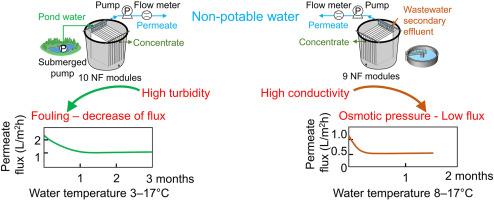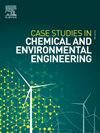Nanofiltration of contaminated water and wastewater using membrane modules reconfigured from commercial spiral-wound elements
Q1 Environmental Science
Case Studies in Chemical and Environmental Engineering
Pub Date : 2025-09-30
DOI:10.1016/j.cscee.2025.101290
引用次数: 0
Abstract
Submerged nanofiltration (NF) membrane treatment can be an attractive approach for water purification because advanced drinking water treatment can be performed at a low energy consumption without pre-treatment. This pilot-scale study aimed to evaluate the feasibility of employing flat-sheet NF membrane modules, adapted from commercial 4-inch spiral-wound elements, to scale up the direct NF treatment of polluted water for the first time. The pilot-scale submerged NF systems operated at a transmembrane pressure of approximately 50 kPa, directly filtering municipal secondary-treated wastewater and zoo pond water as feed sources for over 46 and 99 days, respectively. The initial permeate flux for the secondary-treated wastewater effluent was 1.1 L/m2h, which was half of the 2.0 L/m2h flux for the zoo pond water. This discrepancy is attributed to the high salinity (e.g., high osmotic pressure difference) of the secondary-treated wastewater effluent. Over time, the permeate flux gradually declined due to membrane fouling but eventually stabilized for both feed waters. Despite variations in the quality of the feed water during the experiments, the permeate quality met high water quality standards. This study highlights the potential of direct NF treatment using reconfigured commercial NF membrane modules for sustainable urban water cycle management.

利用商业螺旋缠绕元件重新配置的膜模块对污染水和废水进行纳滤
浸没纳滤(NF)膜处理是一种很有吸引力的水净化方法,因为它可以在不需要预处理的情况下以低能耗进行高级饮用水处理。这项中试规模的研究旨在评估采用平板纳滤膜组件的可行性,该组件由商业4英寸螺旋缠绕元件改编而成,首次扩大了直接纳滤处理污水的规模。中试规模的浸没式纳滤系统在约50 kPa的跨膜压力下运行,直接过滤城市二级处理废水和动物园池塘水作为饲料来源,分别超过46天和99天。二级处理废水出水的初始渗透通量为1.1 L/m2h,是动物园池塘水2.0 L/m2h通量的一半。这种差异是由于二级处理废水出水的高盐度(例如,高渗透压差)造成的。随着时间的推移,由于膜污染,渗透通量逐渐下降,但最终两种给水的渗透通量趋于稳定。在实验过程中,尽管进料水质发生了变化,但渗透水质达到了较高的水质标准。本研究强调了利用重新配置的商用纳滤膜模块进行直接纳滤处理的潜力,以实现可持续的城市水循环管理。
本文章由计算机程序翻译,如有差异,请以英文原文为准。
求助全文
约1分钟内获得全文
求助全文
来源期刊

Case Studies in Chemical and Environmental Engineering
Engineering-Engineering (miscellaneous)
CiteScore
9.20
自引率
0.00%
发文量
103
审稿时长
40 days
 求助内容:
求助内容: 应助结果提醒方式:
应助结果提醒方式:


